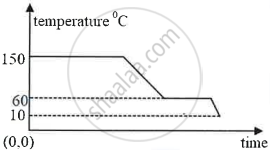Advertisements
Advertisements
प्रश्न
The diagram below shows a cooling curve for a substance:

- State the temperatures at which the substance condenses.
- The temperature range in which the substance is in liquid state.
- Why do we prefer ice to ice-cold water for cooling a drink?
उत्तर
- The substance condenses at 150°C.
- 150°C to 60°C.
- At 0°C, melting 1 g of ice into water requires 336 J of heat energy from the drink. As a result, the drink releases 336 J more heat energy than 1 g ice at 0°C. As a result, 1 g of ice at 0°C produces significantly more cooling than 1 g of water at 0°C.
APPEARS IN
संबंधित प्रश्न
What do you understand by the term latent heat?
The specific latent heat of fusion of water is ______.
A refrigerator converts 100g of water at 20℃ to ice at – 10℃ in 73.5 min. Calculate the average rate of heat extraction in watt. The specific heat capacity of water is 4.2 J kg-1 K-1, specific latent heat of ice is 336 J g-1 and the specific heat capacity of ice is 2.1 J kg-1 K-1.
What is meant by latent heat? How will the state of matter transform if latent heat is given off?
Water expands on reducing its temperature below ______°C.
Explain why water is used in hot water bottles for fomentation and also as a universal coolant.
When 1 g of ice at 0 °C melts to form 1 g of water at 0 °C then, is the latent heat absorbed by the ice or given out by it?
Why does weather become pleasant when it starts freezing in cold countries?
Define the term ‘specific latent heat of fusion’ of a substance.
The specific latent heat of vaporisation of steam is 2260 J/g. Comment on this.
Why do we feel much comfortable when we sit under a moving fan especially when our body is sweating?
Derive an expression for the amount of heat given out or taken up, when its temperature falls or rises by t°C.
If there is no Heat loss to the surroundings, the heat released by the condensation of m1 g of steam at 100°C into water at 100°C can be used to convert m2 g of ice at 0°C into water at 0°C.
(i) Find:
(a) The heat lost by steam in terms of m1
(b) The heat gained by ice in terms of m2
(ii) Form a heat equation find the ratio of m2 : m1
Specific latent heat of vaporization of steam = 2268 kJ/kg
Specific latent heat of fusion of ice = 336 kJ/kg
Specific heat capacity of water = 4200 J/kg°C
Match the columns.
| Column A | Column B |
| 1) Absolute humidity | a) J or cal |
| 2) Latent heat | b) J/kg °C |
| 3) Specific heat capacity | c) kJ/kg |
| 4) Heat | d) no unit |
| e) kg/m3 |
During reheating, ice is converted to water at a temperature of 0 °C.
For the same mass of ice and ice-cold water, why does ice produce more cooling than ice-cold water?
Who introduced the term latent heat?
Calculate the amount of heat required to convert 200g of ice at 0°C into the water at 0°C Specific latent heat of fusion of ice = 336 Jg-1
Specific latent heat of a substance ______.
20 g of ice at 0°C absorbs 10,920 J of heat energy to melt and change to water at 50°C. Calculate the specific latent heat of fusion of ice. Specific heat capacity of water is 4200 J kg-1 K-1.
